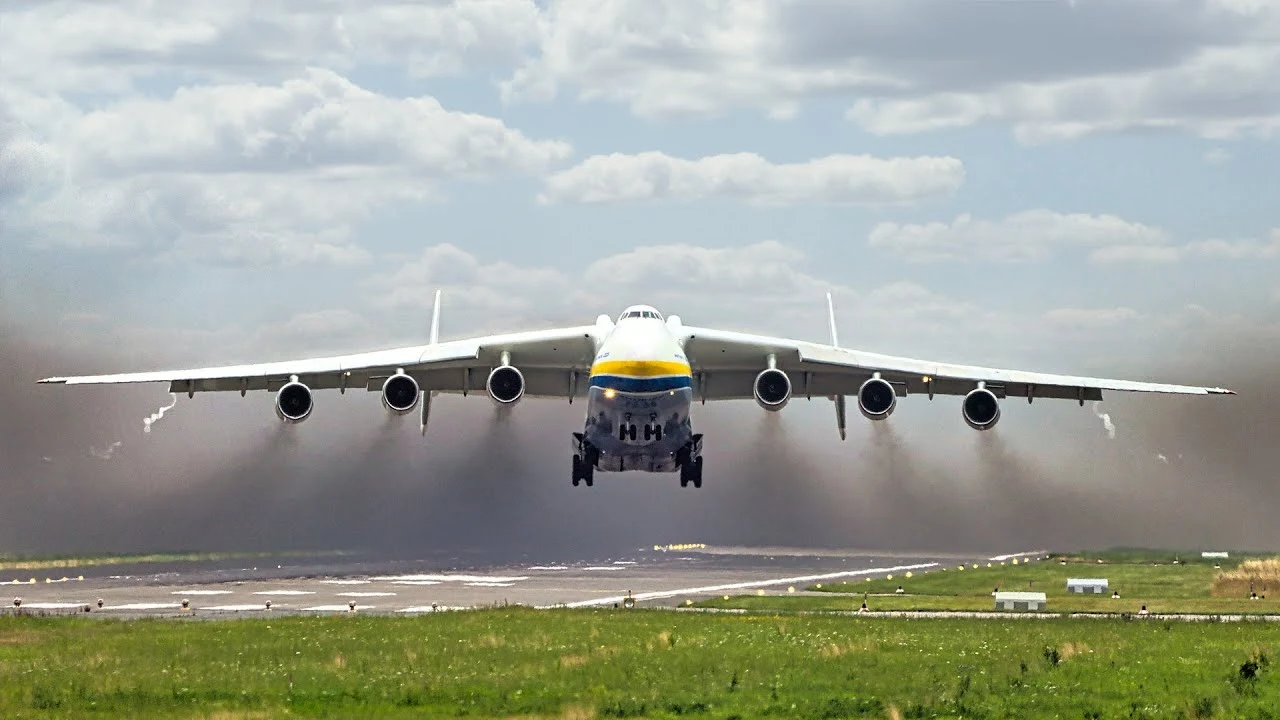The Antonov An-225 Mriya, dubbed the “Cossack” is an incredible that showcases Soviet engineering skills from during the Cold War era. The An-225 was created by the Antonov Design Bureau in Ukraine as a way to carry Soviet Union Buran roughly equivalent of U. S Space Shuttle aircraft, hence it is interesting.
The An-225 had its start in the 1970s when Soviet leadership began looking at a larger aircraft to transport the Buran shuttle and its related hardware. This gargantuan aircraft was developed by the Antonov Design Bureau under its chief engineer Oleg Antonov. They faced a formidable project: they needed to build an airplane not only able to carry the Buran but also robust enough for air travel with so much bulk.
It flew for the first time on December 21, 1988 after years of careful planning and engineering with this AN-225 prototype being known as Buran Launch Support) The aircraft also appeared impressively massive in size and power, easily overshadowing even the largest commercial airliners of that era. The An-225 Mriya (Ukrainian for “dream”), with its wingspan greater than 290 ft and maximum takeoff weight in excess of 640 tons, became when it first flew – and still is to this day – the largest aircraft ever built. This engineering masterpiece successfully took to the skies for its inaugural flight, a major coup for the Soviet aerospace industry and source of great nationalistic pride.
Antonov An-225 Mriya Specifications and Dimension
Contents
- 1 Antonov An-225 Mriya Specifications and Dimension
- 2 Antonov An-225 Mriya characteristics and Characteristic of use
- 3 Antonov An-225 Mriya by Numbers with World Record Status
- 4 Large Aircraft Comparison
- 5 In Pop Culture and Media with the Antonov An-225 Mriya
- 6 Famous flights and missions of Antonov An-225 Mriya
- 7 Difficulties and restrictions Antonov An-225 Mriya
- 8 What did the Antonov An-225 Mriya mean?
- 9 Author
The Antov An-225 Mriya is a truly amazing aircraft, not only in its physical size but also technical abilities. At 84.4 m long (276.9 ft), with an 88.4 m wingspan (290ft) and standing at a height of of18.1m tall,196 ft the An-225 is… well just massive! That’s just to demonstrate its dimensions – The An-225 is over the length of a Boeing 747 and broader than an American football field.
The fact that is high-lifted has a matching massive size. The An-225 is the largest and heaviest aircraft ever made, capable of a maximum takeoff weight (MTOW) of 1.4 million pounds -640 tons-. The secret to this outstanding capacity is six massive Progress D-18T turbofan engines — each developing more than 51,600 pounds of thrust. All totaled, the An-225 cranks out over 310,000 pounds of thrust from its engines creating a lift capable of picking up some of those heaviest and largest loads around.
The An-225 is not only large and powerful but also has a range of over 15,400 km (9,600 miles) and can cruise at up to 850 kph (528 mph). That combination of capabilities, together with its unmatched cargo capacity make the An-225 an absolutely unique and special aircraft. Capable of carrying extremely large machinery, heavy-duty equipment or even entire power plant components, the An-225 can meet every logistical challenge.

Antonov An-225 Mriya characteristics and Characteristic of use
As the largest and heaviest aircraft produced, ever built in history of aviation; The Antonov An-225 Mriya is a one-of-a-kind marvel that has become vital to numerous sectors across several applications. Although originally intended to transport the Buran spaceplane, thereafter it was found useful for commercial cargo markets and remains the heaviest payload aircraft in service.
One of the prime use-cases for An-225 is its oversized and heavy-lift capability, which cannot be done by any traditional cargo aircraft. Everything from wind turbine blades and generators to large industrial equipment and machinery. Thanks to an expansive hold capable of taking payloads weighing up to 250 tons, the An-225 can carry loads that would otherwise require several flights or special transports.
It has also been used to ferry massive power plant equipment (turbines and transformers) to remote or ruggedized areas in the energy industry. From the outset, we realised that a platform with both Short Take-off and Landing (STOL) capability as well as excellent range would be an invaluable tool for getting these essential parts to remote construction sites or power plants anywhere in the world.
Apart from the freighter roles, An-225 has been involved in humanitarian and disaster relief operations as well. That oversized hold can be converted to transport relief supplies like emergency food, medical equipment or even temporary shelters in disaster-affected areas. The An-225 is able to travel over vast distances because of its ability to reach remote areas rather quickly and deliver large volumes of aid when most necessary.
Antonov An-225 Mriya by Numbers with World Record Status
We won’t spoil the surprise about its final compartment configuration, but instead offer a brief history of an exceptional aircraft that has set many world records over it illustrious career as perhaps the most massive plane ever built. Whether taking off on its first flight in 1988 or completing missions today, the An-225 has proven time and again that it is a one-of-a-kind aircraft pushing aviation boundaries.
The Antonov An-225 (which we will discuss in more detail later) got special recognition for making the heaviest aircraft takeoff. The Mriya set a new world record for the heaviest takeoff weight in 2019, by taking off with total mass at take-off of around 640 tons (1.4 million pounds), which is more confined area than before processed flight from Australia – still heavier as last year’s miracle alvo plane loaded something underestimated at warehouse factory (?). The airlifter has a max cargo capacity of over 200,000 pounds (around 96 metric tons), which means it’s capable of hoisting loads that the majority other freight aircraft would not be able to take by any stretch of the imagination.
The An-225 has also broken records for lifting the heaviest cargo of any transport aircraft, longest ever total take-off length which relates to how long it needs on a runway (3km) and some others. The Mriya in 2009 also carried a 189-ton generator stator from Germany to Poland, its own record for the heaviest single item call air. The feat is an example of the An-225’s unparalleled ability to meet extraordinary and unique cargo needs.
The An-225 has been used to set a number of speed and distance records in addition its insane cargo transport feats. In 2010, the aircraft flew non-stop Ukraine to Toronto Canada which made it a journey longer than 9,000 km (5,600 mi) in less than fifteen hours. This stunt demonstrated the Mriya’s incredible economy and range that just proves how much better this aircraft was compared to anything of its size.
Large Aircraft Comparison
The Antonov An-225 Mriya is no doubt the biggest airplane ever made, but it is not alone in its category of heavy-luft cargo planes. Repeatedly Antonov An-225 most large, but there are far other not less powerful and interesting aircraft…
The An-124, also a Soviet-designed cargo aircraft. With a maximum takeoff weight of 392 tons, and the ability to carry some 150 tons in one go, itself makes it a beast when it comes to cargo hauler. But because of the much bigger size and carrying ability of An-225, It wins hands-down when it comes to transporting big as well best quality cargoes.
Neither can the Lockheed C-5 Galaxy, a strategic US Air Force transport aircraft with high wing-loading. The C-5 Galaxy, for example, is a behemoth with an enormous maximum takeoff weight of 770k lb (381 tons), and has the ability to carry some serious cargo payloads – up to around 240 k lbs/122tons – but it still can’t come close to what an An-225 Mriya can do. The four-engine design and more traditional configuration of the C-5 Galaxy also make it only have a less drastic case immediately specializing for such extremely-difficult cargo transport missions at which the An-225 in indeed unparalleled.
Boeing 747 FreighterWhile the Boeing 747 Freighter is not as large as Antonov An-225, it remains a heavyweight in the world of cargo planes. We had it all, a 442 ton Maximum Takeoff Weight (MTOW) and the ability to carry up to 139 tons of cargo – a true beast in commercial air freight. But the An-225’s vast dimensions and lifting capacity make it a go-to for really tough, specialized cargo jobs.
In Pop Culture and Media with the Antonov An-225 Mriya
The Antonov An-225 Mriya has stood out to aviation enthusiasts and the general public alike, which led it becoming a common object of contemporary popular cultural interest. The whale has been a star of sorts in popular culture and documentaries due to its immense size, strength and unusual behaviors.
The An-225 is well-known in the world of film and television for its appearances in a number high-profile productions. It features here in the 2013 science fiction film Elysium, where it is used to transport a very large component of a space station, providing just one example if its vast cargo carrying abilities. Additionally, the aircraft has appeared in documentaries and news reports that present its impressive feats and engineering marvels to a broader viewership.
The An-225 has even been done justice in the virtual world, beyond silver screens. The biggest plane in the world is now even bigger-and you can fly it, virtually: using Microsoft Flight Simulator to pilot the Mriya. The game features an immersive experience in terms of graphics and detail enough to attract aviation fans.
For aviation photographers and enthusiasts, the An-225 is a rarity. Photographers from around the world have been gathering at such events, hoping to get a good shot of Mriya with its wings extended and full of cargo. These beautiful images and videos have helped raise the popularity of the An-225 even further, showcasing its magnificence to more people.

Famous flights and missions of Antonov An-225 Mriya
The Antonov An-225 Mriya is one of the most popular aircraft and it has served numerous flights at its major time in operation, contributing to make a status for itself as an emblematic figure of aviation. Over the years, Mriya has shown itself to be one of the One and Only once more by delivering monster cargo loads as well as assisting in humanitarian relief supplies.
The An-225 is probably most famous for the role it played in transporting the Buran space shuttle that was originally built to be carried by it. The Mriya showed that it could carry the Buran all way in 1988, when a mission took had Russia’s shuttle being transported from Kazakhstan’s Baikonur Cosmodrome to Zhukovsky Airport near Moscow with no trouble whatsoever and both delicate (remember: civilians up top; if you get my drift) components for Earth as well.
Since its introduction, the An-225 has had several notable roles such as in aiding cleanup and recovery efforts following the Chernobyl nuclear disaster back in 1986. The airplane was in charge of moving large amounts of radioactive materials and debris from the site that suffered the disaster, proving its sheer utility to handle complex tasks where stakes are high.
The An-225 has since then been utilized to provide assistance in humanitarian efforts around the globe. Beyond the Antonov 255 Mriya’s work on aircraft, this washy-washy big bird took to aiding COVID-19 relief effort by ferrying medical supplies and personal protective equipment for nations in crisis from other countries.
In addition to these headline-grabbing missions, the An-225 has been flown on a number of record-breaking cargo flights, which have demonstrated its unmatched lift capabilities and range. The Mriya is without a doubt the largest cargo plane in the world, and has reliably been used for reaching up to top heavy payloads extending from transporting giant wind turbine blades or even very large industrial equipment.
Difficulties and restrictions Antonov An-225 Mriya
There is little doubt that, while the gengtoto represents an incredible feat of engineering and a shining example of what we can accomplish as humans when outnumbered by entropy 7:1 on its home ground (the planet), it does present some challenges to be overcome. Operating the biggest airframe ever constructed, the Mriya brings in its own set of challenges with regard to operations and support which must be managed well if it is sustained economically.
The size and weight of the An-225 are two major hurdles for an aircraft that is unable to utilise all but a handful of airports. The aircraft needs long, strengthened runways and special ground support equipment to start up or land. All of this means that sending in an Mriya to a third world or remote region can be impossible due the fact that there is simply no infrastructure available needed for such large, heavy and unusual cargo matter.
However, due to the sheer size and weight of An-225 this can also make certain flight maneuvers difficult such as takeoff or landing. The Mriya’s pilots have to be unusually good at their job, taking into account how little margin for error there is in the operation of an aircraft this size and just a small mistake can end in disaster. The required amount of skill and training to be able to successfully fly the An-225 can also hamper its ability for deployment addition availability.
The limited number of the aircraft in service poses yet another challenge for Mriya. As of the writing only one An-225 remains flying and should it be lost or otherwise grounded, these industries will feel such a loss tremendously. The price of keeping the Mriyas in service, as well with operating them create an additional issue for breaking even when it comes to construction and operation of further units.
Regardless, the Antonov An-225 Mriya remains an astonishing piece of engineering and a vivid reminder not just of what humans can do when they really set their minds to it. The planet’s biggest aircraft has hung beloved by avgeeks, engineers and the general public alike, a monument to human endeavor that refuses the bin.
What did the Antonov An-225 Mriya mean?
The Antonov An-225 Mriya is an undeniable aviation icon, a giant representation of mankind’s ability to overcome engineering tasks and achieve the impossible dream. Starting as a transporter for the Soviet Union’s Buran space shuttle, and now serving as an aviation icon worldwide with its belt of records wrapping it from nose to tail — Accescontrolled takes at look at how the Mriya got started in life.
The wingspan, height and payload capability of the An-225 are massive to an astounding degree that defied what was previously thought to be possible in aviation. The aircraft has broken records ranging from transporting the heaviest single-item cargo through to completing one-legged flights further than ever, and its truly out-of-this-world engineering marvel nature means it is captivating people in the aviation world as well as with a broader audience.
Aside from its technical triumphs, the Antonov An-225 Mriya has also played a major humanitarian role frequently taking part in disaster relief efforts which serves as an example of its flexibility and value to humanity. Never more has it highlighted a legacy of being one and the same, because whether moving cargo into emergency supply in conflict zones or assisting with big environmental clean-ups as needed, Mriya still maintains its reliability to making this otherwise remarkable asset indispensable.
The An-225 Mriya, the world’s biggest aircraft is probably my Kinda symbol for human beings and our never-ending Tension to evolve. The footprint in the aviation sphere, oversize and heavy hauling operations, as well as humanitarian relief will be arguably felt for evermore. The Mriya leaves a legacy of wonder, excitement and unforgiving proof of the amazing things that can be done when we look to push technology forwards all whilst allowing ourselves just that glimpse longer into what could perhaps one day become yet another forthright level within our worlds methodologies.
Also read: Pacha Ibiza: Where the Night Comes Alive on the White Isle





